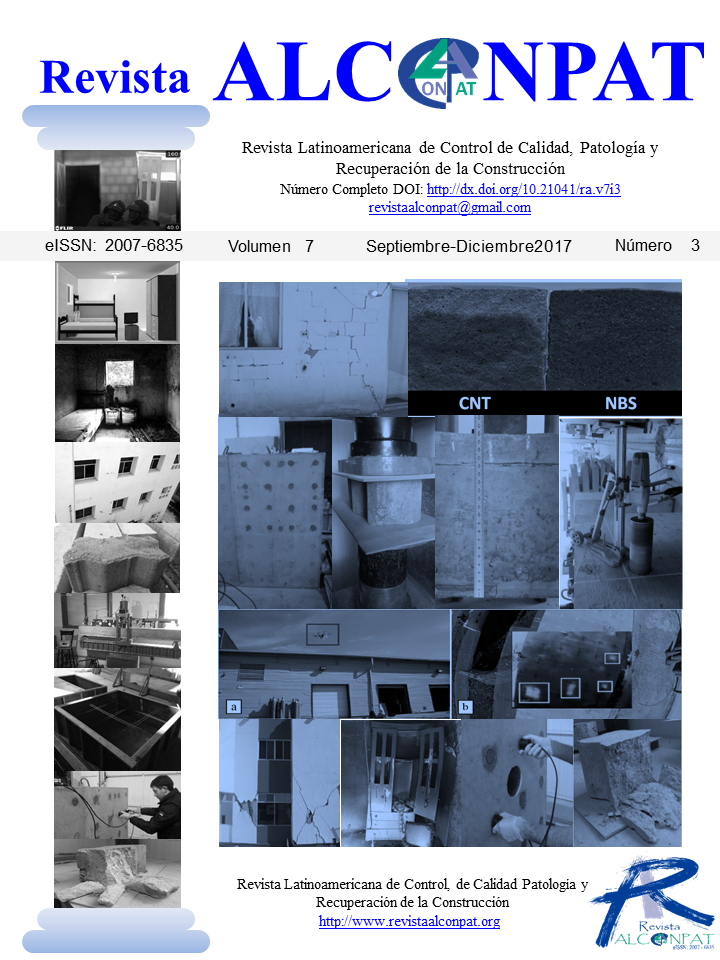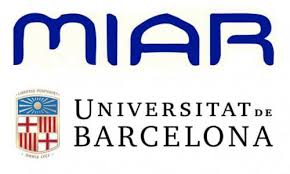Parametric analysis of carbonation process in reinforced concrete structures through Artificial Neural Networks
Abstract
The aim of this paper is parametrically analyze the main factors that influence on the progress of concrete carbonation front. Therefore, a numerical model was developed using Artificial Neural Networks (ANNs), considering the Multi-Layer Perceptron class, designed in a C++ object-oriented program. The software was fed by experimental degradation data available in the current literature. The results obtained in the parametric analysis, besides adding knowledge to the building pathology area, reinforce concepts already known in the literature, demonstrating the efficiency of ANNs in the investigation of concrete carbonation.
Downloads
References
American Society for Testing and Materials. ASTM C 150: Standard Specification for Portland Cement. Philadelphia, 2001.
American Society for Testing and Materials. ASTM C 595: Standard Specification for Blended Hydraulic Cements. Philadelphia, 2003.
Andrade, C. (1992), “Manual para diagnóstico de obras deterioradas por corrosão de armaduras”, Tradução de Antônio Carmona e Paulo Helene, São Paulo: PINI, p. 104.
Andrade, J. J. O., Possan, E., Dal Molin, D. C. C. (2017), “Considerations about the service life prediction of reinforced concrete structures inserted in chloride environments”, Journal of Building Pathology and Rehabilitation 6, pp. 1–8.
Aranha P. M. (1994), “Contribuição ao estudo das manifestações patológicas em estruturas de concreto armado na região Amazônica”, Dissertação de Mestrado em Engenharia, Escola de Engenharia, Escola de Engenharia, Universidade Federal do Rio Grande do Sul, Porto Alegre.
Associação Brasileira de Normas Técnicas. NBR 11578: Cimento Portland composto. Rio de Janeiro, 1991.
Associação Brasileira de Normas Técnicas. NBR 5733: Cimento Portland de alta resistência inicial. Rio de Janeiro, 1991.
Associação Brasileira de Normas Técnicas. NBR 5735: Cimento Portland de alto forno. Rio de Janeiro, 1991.
Associação Brasileira de Normas Técnicas. NBR 5736: Cimento Portland pozolânico. Rio de Janeiro, 1991.
Bakker, R. M. F. (1988), Initiation period. In: Schiess P. “Corrosion of steel in concrete”, London, Chapman and Hall, cap. 3, pp. 22-55.
Bob, C., Afana, E. (1993), “On-site assessment of concrete carbonation”, Proceedings of the International Conference Failure of Concrete Carbonation, RILEM, Bratislava, pp. 84–87.
Braga, A. P., Ludemir, T. B. Carvalho, A. C. (2000), “Redes Neurais Artificiais: Teoria e Aplicações”, Rio de Janeiro: LTC – Livros Técnicos e Científicos Editora.
Chang, C. F., Chen, J. W. (2006), “The experimental investigation of concrete carbonation depth”, Cement and Concrete Research, V.36, pp. 1760–1767.
Comission Permanente del Hormigón, EHE (2008), “Instrucción de Hormigón Estructural. Ministério de obras públicas e urbanismo”. Madrid, Espanha.
Dal Molin, D. C. C. (1988), “Fissuras em estruturas de concreto armado: análise das manifestações típicas e levantamento de casos ocorridos no Estado do Rio Grande do Sul”, Dissertação de Mestrado em Engenharia, Universidade Federal do Rio Grande do Sul, Porto Alegre.
Felix, E. F. (2016), “Desenvolvimento de software para a estimativa da profundidade de carbonatação, vida útil e captura de CO2 de estruturas de concreto empregando RNA’s”, Trabalho de conclusão de curso, Universidade Federal da Integração Latino-Americana, Foz do Iguaçu.
Güneyisi, E. M., Mermerdas, K., Güneyisi, E., Gesoglu, M. (2014), “Numerical modeling of time to corrosion induced cover cracking in reinforced concrete using soft-computing based methods”, Materials and Structures 48, pp. 1739–1756.
Hamada, M. (1969), “Neutralization (carbonation) of concrete and corrosion reinforcing steel”, proceeding of the 1969 International Symposium on the Chemistry of Cement, Part III, v. II/4, pp. 343–369.
Helene, P. R. L. (1993), “Contribuição ao estudo da corrosão em armaduras de concreto armado”, Tese Livre Docência, Escola Politécnica da Universidade de São Paulo, São Paulo.
Houst, Y. F., Wittmann, F. H. (2002), “Depth profiles of carbonates formed during natural carbonation”, Cement and Concrete Research 32, pp. 1923–1930.
Ishida, T., Maekawa, K. (2001), “Modeling of pH profile in pore water based on mass transport and chemical equilibrium theory”, Concrete Library of JSCE 37, pp. 151–166.
Izumi, I., Kita, D., Maeda, H. (1986), “Carbonation”, Kibodang Publication, pp. 35–88.
Jiang, L., Lin, B., Cai, Y. (2000), “A model for predicting carbonation of high-volume fly ash concrete”, Cement and Concrete Research 30, pp. 699–702.
Kari, O. P., Puttonen, J., Skantz, E. (2014), “Reactive transport modelling of long-term carbonation”, Cement and Concrete Composites 52, pp. 42–53.
Kobayashi, K., Uno, Y. (1990), “Mechanism of carbonation of concrete”, Concrete Library of JSCE 16, pp. 139–151.
Konzen, P. H. A., Felix, E. F. (2011), Pacote computacional de RNAs orientado-a-objetos project-yapy. Disponível em: <https://code.google.com/archive/p/project-yapy>.
Kulakowski, M. P., Pereira, F. M., Dal Molin, D. C. C. (2009), “Carbonation-induced reinforcement corrosion in silica fume concrete”, Construction and Building Materials 23, pp. 1189–1195.
Kwon, S. J., Song, H. W. (2010), “Analysis of carbonation behavior in concrete using neural network algorithm and carbonation modeling”, Cement and Concrete Research 40, pp. 119–127.
Lu, C., Liu, R. (2009), “Predicting carbonation depth of prestressed concrete under different stress states using artificial neural network”, Advances in Artificial Neural Systems 2009, pp. 1–8.
Maekawa, K., Ishida, T., Kishi, T. (2003), “Multi-scale modeling of concrete performance”, Journal of Advanced Concrete Technology 1, pp. 1–126.
Meira, G. R., Padaratz, I. J., Borba Júnior, J. C. (2006), “Carbonatação natural de concretos: resultados de cerca de quatro anos de monitoramento”. In: Encontro Nacional de Tecnologia do Ambiente Construído, Florianópolis, Antac, Porto Alegre.
Neville, A. M. (1997), “Propriedades do concreto”, São Paulo: PINI, p. 828.
Papadakis, V. G., Vayenas, C. G., Fardis, M. N. (1991), “Fundamental modeling and experimental investigation of concrete carbonation”, ACI Materials Journal 88, pp. 363–373.
Parrot, L. J. (1987), “A review of carbonation in reinforced concrete”. Cement and concrete Association report.
Pauletti, C., Possan, E., Dal Molin, D. C. C. (2007), “Carbonatação acelerada: estudo da arte das pesquisas no Brasil”, Ambiente Construído 7, pp. 7–20.
Possan, E. (2010), “Modelagem da carbonatação e previsão de vida útil de estruturas de concreto em ambiente urbano”, Tese de Doutorado em Engenharia Civil, Programa de Pós-Graduação em Engenharia Civil, Universidade Federal do Rio Grande do Sul, Porto Alegre. http://www.lume.ufrgs.br/handle/10183/28923.
Possan, E., Andrade, J. J. O. (2014) “Markov Chains and reliability analysis for reinforced concrete structure service life”, Materials Research, v. 17, p. 593-602.
Possan, E., Thomaz, W. A., Aleandri, G. A., Félix, E. F., Dos Santos, A. C. P. (2017), “CO2 uptake potential due to concrete carbonation: A case study”, Case Studies in Construction Materials 6, pp. 147–161.
Smolczyk, H. G. (1069), “Written Discussion”, proceeding of the 1969 International Symposium on the Chemistry of Cement, Part III, v. II/4, pp. 369–384.
Taffese, W. Z., Sistonen, E. (2013), “Service life prediction of repaired structures using concrete recasting method: state-of-the-art”, Procedia Engineering 45, pp. 1138–1144.
Taffese, W. Z., Sistonen, E., Puttonen, J. (2015), “CaPrM: Carbonation prediction model for reinforced concrete using machine-learning methods”, Construction and Building Materials 100, pp. 70–82.
Talukdar, S., Banthia, N., Grace, J. R. (2012), “Carbonation in concrete infrastructure in the context of global climate change – Part 1: Experimental results and model development”, Cement and Concrete Composites 34, pp. 924–930.
Vesikari, E. (1988), “Service life prediction of concrete structures with regard to corrosion of reinforcement”. Technical Research Centre of Finland, report n. 553, Finland p. 53.
_______________________________
License in effect from September 2020
You are free to:
- Share — copy and redistribute the material in any medium or format for any purpose, even commercially.
- Adapt — remix, transform, and build upon the material for any purpose, even commercially.
- The licensor cannot revoke these freedoms as long as you follow the license terms.
Under the following terms:
- Attribution — You must give appropriate credit , provide a link to the license, and indicate if changes were made . You may do so in any reasonable manner, but not in any way that suggests the licensor endorses you or your use.
- No additional restrictions — You may not apply legal terms or technological measures that legally restrict others from doing anything the license permits.
Notices:
You do not have to comply with the license for elements of the material in the public domain or where your use is permitted by an applicable exception or limitation .
No warranties are given. The license may not give you all of the permissions necessary for your intended use. For example, other rights such as publicity, privacy, or moral rights may limit how you use the material.





















.png)














